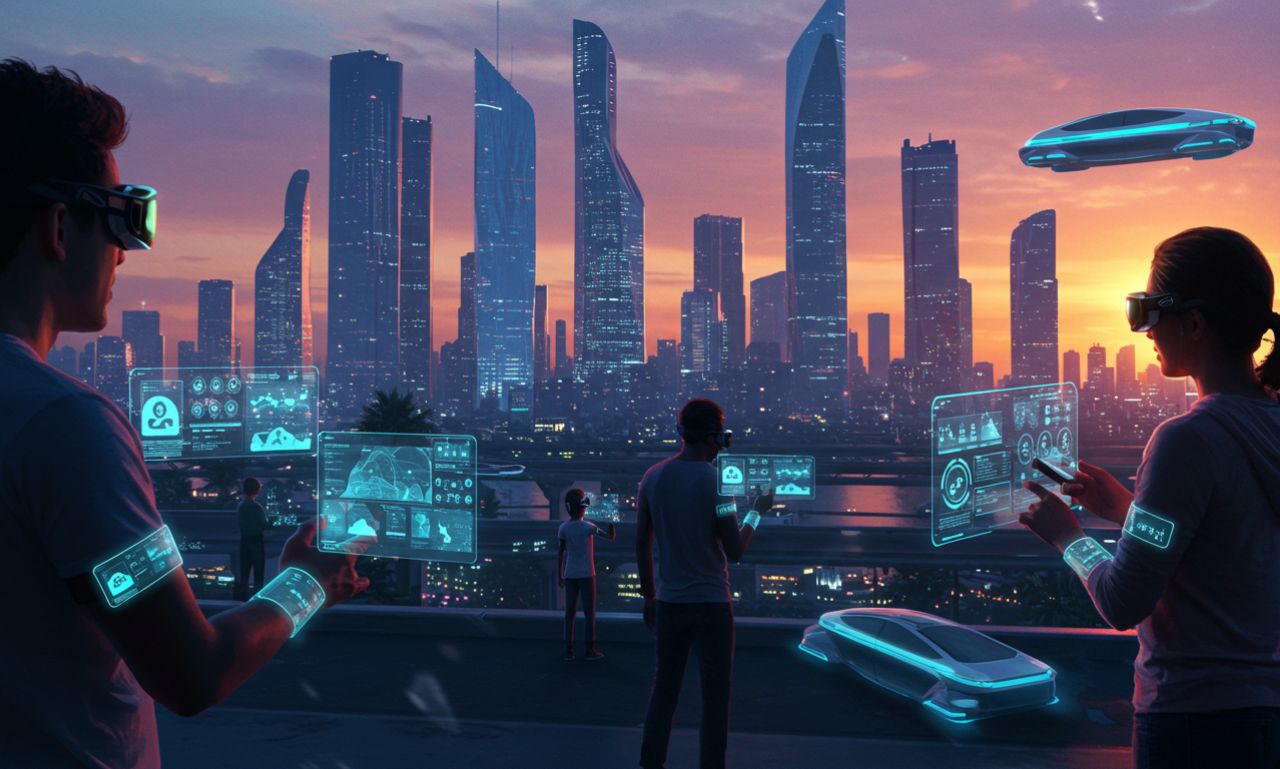Tech Giants Envision Future Beyond Smartphones
For over a decade, smartphones have been our primary connection to the digital world. They replaced cameras, radios, maps, and even wallets. Yet, as powerful as they are, the world’s largest technology companies believe the smartphone era is reaching its peak. Tech giants envision future beyond smartphones where augmented reality glasses, wearable devices, brain-computer interfaces, and intelligent AI assistants redefine how humans interact with technology.
Why Smartphones Are Reaching Their Limits
The smartphone has evolved remarkably, but physical limits are showing:
-
Screen size can only grow so much before devices become impractical.
-
Battery life struggles to keep up with intensive usage.
-
Interface overload—too many apps, too many notifications, and too little focus.
This has left tech giants exploring new frontiers that move digital interaction beyond the glass screen in your hand.
Apple’s Vision: Spatial Computing and Foldables
Apple is taking a two-track approach.
-
Vision Pro headset: Apple’s bet on spatial computing blends real and digital environments. Eye tracking, gesture recognition, and immersive 3D apps aim to make screens feel outdated.
-
Foldable iPhones: At the same time, Apple is rumored to be testing foldable designs to keep the iPhone relevant during this transition.
-
AI integration: Tim Cook has emphasized that artificial intelligence could be “as big as the internet,” embedding it deeper into Apple’s future products.
For Apple, the path beyond smartphones doesn’t abandon them—it transforms them.
Meta’s Big Push: AR Glasses and the Metaverse
Mark Zuckerberg sees smart glasses as the natural successor to smartphones.
-
Ray-Ban Meta smart glasses already combine fashion with translation, camera, and AI-driven features.
-
Project Orion is designed as a full-fledged AR wearable that could replace both smartphones and laptops.
-
The metaverse remains Meta’s long-term vision, making digital worlds accessible through lightweight wearable devices rather than bulky headsets.
Meta is betting heavily that augmented reality will become the new default computing platform.
Microsoft’s Path: Enterprise AR and AI
Unlike Apple or Meta, Microsoft is focused on professional use:
-
HoloLens is already in use across healthcare, defense, and engineering, allowing workers to interact with holograms.
-
Copilot AI integrates into daily workflows, making collaboration seamless.
-
Their vision beyond smartphones is work-focused rather than consumer-first.
Google’s Wearables and Ambient AI
Google’s direction is subtler but no less ambitious:
-
Google Glass may have failed early, but lessons learned fuel Project Iris, a next-gen AR headset.
-
Wear OS powers smartwatches and could expand into rings or other subtle devices.
-
Gemini AI assistant drives Google’s “ambient computing” dream—technology that works in the background, surfacing information only when needed.
Google imagines a future where you won’t need a screen—you’ll simply ask, and AI will respond in the moment.
Samsung’s Health-Centric Wearables
Samsung is diversifying away from just phones:
-
Galaxy Rings are rumored to monitor health metrics far more discreetly than a watch.
-
Foldable phones remain their way of stretching smartphone innovation further.
-
6G leadership ensures Samsung is prepared to deliver the network backbone that these futuristic devices will rely on.
Samsung sees the body itself as the next platform—rings, watches, and even implants could replace the smartphone.
Amazon’s Invisible Tech: Voice and Smart Homes
Amazon isn’t making phones, but Alexa-powered devices represent a different vision:
-
Echo Frames glasses bring voice AI on the go.
-
Ambient Alexa makes smart homes run on autopilot.
-
Voice commerce could reshape how we shop—no screens required.
For Amazon, the future is one where tech fades into the background, always listening and responding invisibly.
AI: The Invisible Engine of the Future
Across all giants, one trend stands out—artificial intelligence is becoming the foundation.
-
AI personal assistants anticipate needs without asking.
-
Real-time translation breaks down language barriers.
-
Predictive AI helps manage health, work, and learning.
AI isn’t replacing smartphones directly—it’s making them irrelevant.
6G: The Next Infrastructure Revolution
The 6G network, expected around 2030, will fuel this shift:
-
Ultra-low latency for real-time holograms.
-
Lightning-fast speeds for immersive AR and VR.
-
Ubiquitous coverage for always-connected devices.
Without 6G, these visions remain science fiction. With it, they become inevitable.
Brain-Computer Interfaces: The Wild Frontier
The most radical move beyond smartphones is direct thought control:
-
Neuralink, Elon Musk’s company, is testing implants allowing paralyzed patients to control devices with their thoughts.
-
Meta’s EMG projects use wristbands that detect muscle signals, turning them into digital commands.
If successful, these could make screens unnecessary—imagine sending a message just by thinking it.
What This Means for You
-
Short term: Expect more foldables, smarter wearables, and stronger AI inside apps.
-
Medium term: AR glasses could replace your phone by the 2030s.
-
Long term: Brain interfaces may eliminate the need for physical devices entirely.
Conclusion
Tech giants envision a future beyond smartphones not because phones are failing, but because they’re limited. Apple is betting on spatial computing, Meta on AR, Microsoft on enterprise AR, Google on ambient AI, Samsung on wearables, and Amazon on invisible voice tech.
The next decade won’t just change devices—it will change how we live, work, and think. The future beyond smartphones is not about replacing them with a single gadget—it’s about creating a world where technology feels natural, seamless, and almost invisible.
